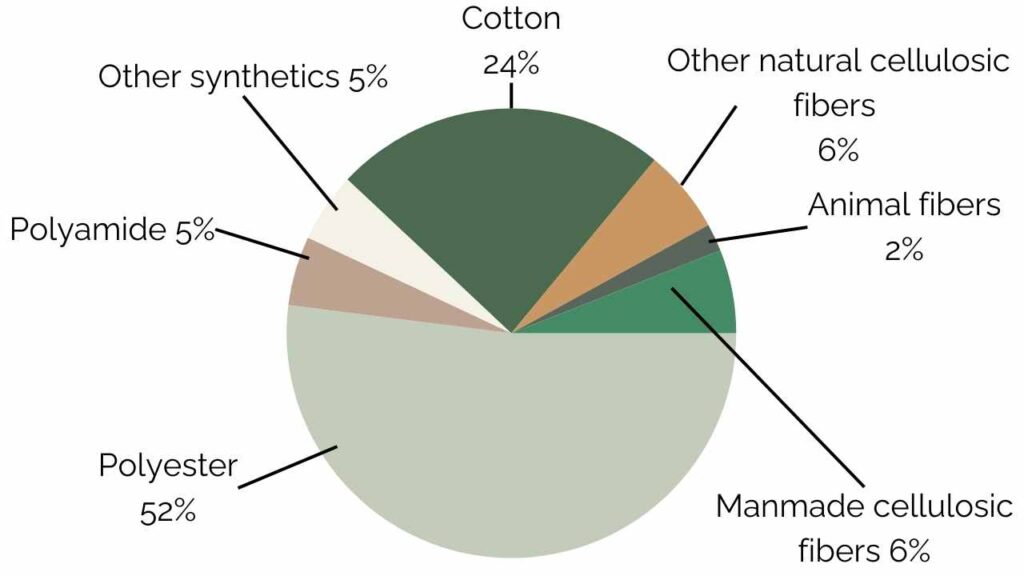Every fibre matters in weaving a sustainable future
In the world of textiles, there are two primary threads: natural and synthetic fibers, or a blend of both, known as semi-synthetic fiber. Each type offers distinct advantages and disadvantages, impacting both the environment and our experience with clothing. The textile industry’s impact on global warming is significant, and the following numbers are alarming. It is responsible for 10% of the world’s global carbon footprint, and at least 20% of global clean water pollution. Up to 700,000 microplastic fibers can be discharged in one laundry filled with polyester clothes, and approximately 20% of the world’s waste comes from the textile industry!
While these numbers are scary, it’s important to remember that reusing is the most sustainable way to consume. But if we have to produce new, then it is important to really understand the impacts that each material can have on us and our environment.
In this article, we will explore the production processes, environmental footprint, and user experience of the most frequently used fibers.
Distribution of world production of textile fibers in 2020*
This chart reveals a global textile fiber production landscape dominated by synthetics in 2020. Synthetic fibers, known for their affordability, versatility, and wrinkle resistance, comprised a whopping 64% of production, with polyester alone accounting for over half (52%). This trend reflects rising global fiber consumption driven by population growth and increasing living standards. This production is expected to reach 156 million tonnes by 2030, with fibers being used for clothing, household items, and technical textiles. However, the environmental impact of synthetic fabrics is very alarming and dangerous for our future if the trend of massive production continues.

| Type of Fabric | Natural | Synthetic | Semi-Synthetic |
|---|---|---|---|
| Type of fabric |
|
|
|
| Origin |
|
|
|
| Impact on Planet |
|
|
|
| Impact on Us |
|
|
|
Here’s a closer look at the decomposition rates of some common fibers:

In every walk with nature, one receives far more than he seeks,”
John Muir
Fast fashion, characterized by excessive new collection launches and low prices, has significant environmental impact. It is produced in large quantities using a lot of synthetic materials, and is commonly produced in working conditions that are very poor. The sustainable fashion alternative places importance on reducing overall consumption, employing more traditional or environmentally friendly production methods, and paying fair wages to the workers involved. The production line is very large and involves a lot of different suppliers, making it difficult to obtain complete transparency in this field. In order to avoid greenwashing, it is essential to be aware of the certifications and to question the brands and suppliers in case you have any doubts.
It can be complicated to actually choose wisely without the right information. The choice between natural and synthetic fibers hinges on a delicate balance of environmental impact, comfort, and care. Understanding these nuances empowers consumers to make informed decisions that align with their values and lifestyle needs. And that is why writing this article was important for us. Without any prior knowledge in 2016, we started our journey in this industry and had to make decisions in this vast field of possibilities. Working with natural fibers was always a top priority for us, and we got to meet many change-makers in the field who gave us hope for a brighter future.
At Green Tailor
We are committed to offering natural fabrics and products made from eco-friendly materials. By prioritizing natural fibers and environmentally conscious practices, we ensure that our products not only look good but also have a minimal environmental footprint.
Check out https://green-tailor.com/shop to explore our collection and join us in making a positive impact on the planet. Choose Green Tailor for your next purchase and be part of the sustainable fashion movement.
Ressources:
– https://www.europarl.europa.eu/topics/en/article/20201208STO93327/the-impact-of-textile-production-and-waste-on-the-environment-infographics
– https://www.close-the-loop.be/en/phase/3/end-of-life
eprints.ugd.edu.mk/30372/1/ANALYSIS
